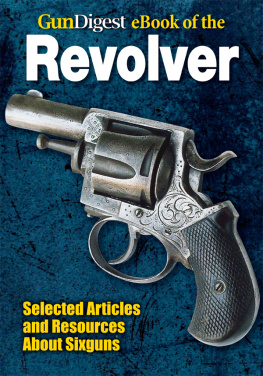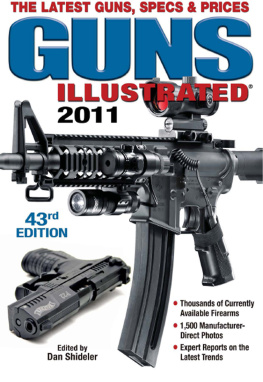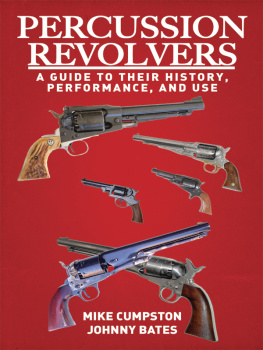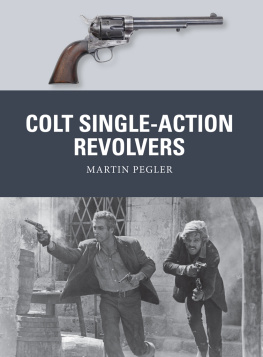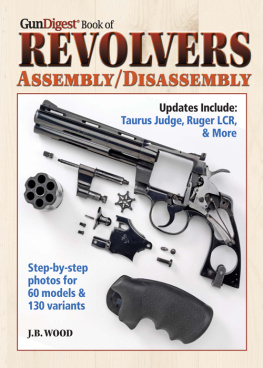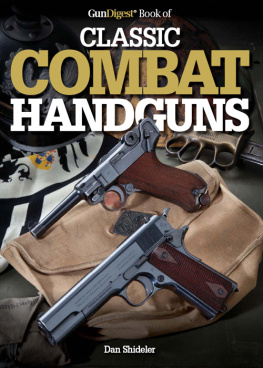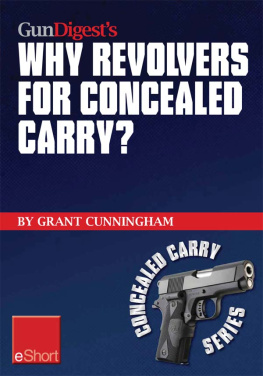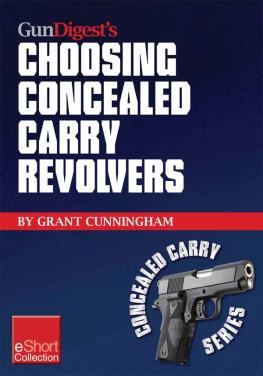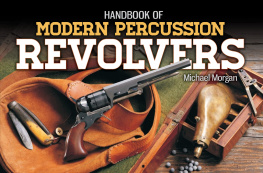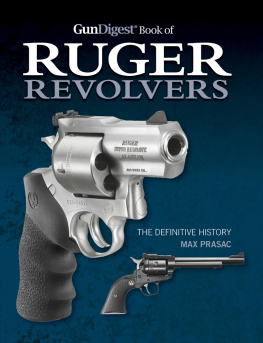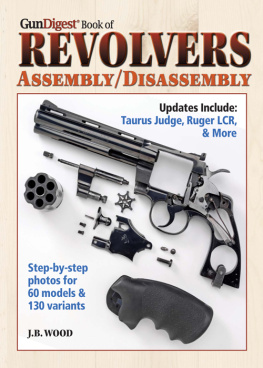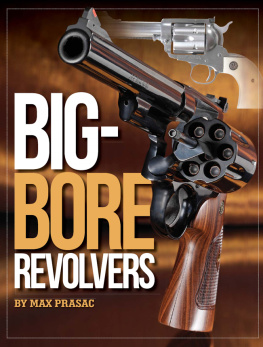GunDigest eBook of the
Revolver
Selected Articles
and Resources
About Sixguns
One
The .38 S&W
The Little Round That Refuses to Die
By David J. Lapell
1942 Vintage Smith & Wesson .38-200 British Lend Lease revolver.
It has been known by many names throughout its long life: the .380/200, the .38 New Police, the Belgian 9mm revolver, but it first started off as the lowly .38 S&W.
In 1876 Smith & Wesson began producing their new First Model Baby Russian revolver chambered in a new cartridge, the .38 S&W. Given its nickname because of the resemblance to the larger Smith & Wesson No. 3 Russian, the First Model was a five-shot single action revolver that was offered with either a 3-1/2 inch or 4-inch barrel and was ideal for concealing in a vest or pants pocket. Both the revolver and the new .38 caliber cartridge proved to be an instant success. All of the small, concealable handguns prior to that were chambered mostly in .22 and .32 rimfire, leaving much to be desired in the realm of stopping power. The Smith & Wesson First Model and the .38 S&W bridged the gap between the little underpowered pocket guns and the larger, more powerful revolvers that were too difficult to conceal.
Originally loaded with just over 9 grains of black powder and a 146-grain lead bullet, the .38 S&W had an average muzzle velocity of 740 fps and a muzzle energy of around 175 ft. lbs. While not anything to write home about in this day and age, it was far superior to the ballistics of the .32 Long, which delivered a 90-grain bullet at a little over 900 fps.
With the popularity of the .38 S&W cartridge and the First Model, Smith & Wesson wasted no time in bringing out their Double Action First Model in 1880, which resulted in a whole series of small revolvers that in one form or another would be produced until 1940. These little pocket-sized guns proved so successful that their basic premise was copied by Iver Johnson, Hopkins & Allen, Harrington & Richardson, and a whole host of others in America and abroad. In fact, one such revolver was used in an attempt to cut short the life of one of Americas greatest Presidents.
This photo shows the United States property markings that are found on British Lend Lease revolvers.
On October 14, 1912, Theodore Roosevelt was in Milwaukee, Wisconsin, campaigning for a return to the White House after four years out of office. Teddy had just left his hotel when a bartender named John Schrank stepped out from his hiding place and fired a single shot from a .38 S&W revolver. Schrank later claimed that the ghost of President William McKinley told him to kill Roosevelt because no man should have more than two terms in office as President. (Roosevelt was trying for a third.)
Schrank was quickly tackled before he could get another shot off, and when Roosevelts aide asked if he had been hurt, Teddy replied, He plinked me, Henry. That single bullet had passed through Roosevelts overcoat, his folded speech that was in his pocket, and his metal eyeglass case before stopping three inches deep into his chest. True to form, the former Commander in Chief refused medical attention and delivered his speech despite the fact he was bleeding profusely. When he later went to the hospital doctors found that the bullet was too close to Roosevelts heart to remove. Despite his wound, the Bull Moose was back out on the campaign trail only six days later.
Smith & Wesson continued to make break open pocket revolvers in .38 S&W, and in 1917, began producing their .38 S&W Regulation Police, a five shot Hand Ejector built on their I-frame line. The I-frame revolvers were too small for the then fairly new .38 Special but were perfect for the shorter .38 S&W. The Regulation Police came with fixed sights and a 4-inch barrel.
In 1936, Smith & Wesson began making a 2-inch barreled version of the Regulation Police called the Terrier. These guns proved to be very popular for concealed carry, and are still quite popular to this day in some circles.
Yet no matter how well liked these new guns were, the .38 S&W was still primarily found in the small break-open pocket revolvers. With new cartridges like the .357 Magnum being introduced in 1935 along with small semi-automatic pistols like those from Colt, the .38 S&W appeared to be on a short road to obsolescence. Then a savior came from the most unlikely of places, the British Empire.
Small .38 S&W-chambered revolvers like this one from US Revolver Company were made by the hundreds of thousands.
For the latter part of the nineteenth and early part of the twentieth centuries the British supplied Her Majestys soldiers with large-caliber revolvers. After the end of WWI someone in charge of British Ordnance came to the conclusion that a 200-grain bullet in .38 caliber would be just as effective in combat as their tried-and-true 260-grain .455 Webley. So in 1922 the new Enfield No. 2 top break revolver was unveiled and chambered in the British version of the .38 S&W. The British round differed from the American .38 S &W with its heavier 200-grain lead round-nose bullet that was backed with 2.8 grains of Neonite powder for a muzzle velocity of 630 fps and a muzzle energy of 175 ft. lbs. The new round was dubbed the .380/200 Cartridge Revolver Mk I. Prior to World War II, however, the British feared that the 200-grain lead bullet of the .380/200 violated the Hague Convention of 1899s ban on exploding bullets, so they replaced them with a 178-grain jacketed round-nose bullet. This new round was called the Cartridge Pistol .380 Mk IIz. The British continued to use the older .380/200 rounds for training purposes, but when World War II broke out both the 200- and 178-grain loads were issued to the troops as ammunition was in short supply.
The outbreak of the war found the British also lacking in handguns, so they quickly turned to the United States for help. This came in the form of the Smith & Wesson Military & Police revolver. The British had originally contracted Smith & Wesson to produce a lightweight 9mm semi-automatic rifle. The gun proved to be unreliable and the idea and the rifles were scrapped. To make up for the money that had been advanced to Smith & Wesson, a deal was struck to provide the British with Military & Police revolvers at the rate of $20 each.
In March, 1940 Smith & Wesson began producing Military & Police revolvers chambered in .38 S&W, and these were so marked on the right side of the barrel. Other than the caliber, these guns were mechanically identical to the .38 Smith & Wesson Special guns that were already being turned out. Soon the entire factory was dedicated to the production of revolvers that were to be shipped to England. By December of 1940, 112,584 Military & Police revolvers chambered in .38 S&W had been manufactured and sent overseas as part of the Lend-Lease program. While these guns have the look of the Smith & Wesson Victory model revolvers with their lanyard rings and plain finish, they lack the V and SV serial number prefixes that did not start until April of 1942 at serial number 1,000,000. These earlier Lend-Lease revolvers were marked with UNITED STATES PROPERTY and U.S. PROPERTY on the top strap with ordnance markings on the butt.

